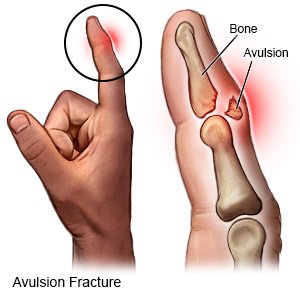Avulsion Fracture
Medically reviewed by Drugs.com. Last updated on Aug 4, 2025.
AMBULATORY CARE:
An avulsion fracture
is when a small piece of bone breaks and pulls away from a larger bone. Part or all of the piece may break away.
 |
Common signs and symptoms of an avulsion fracture:
- Pain, tenderness, and swelling
- Trouble moving the area near the avulsion fracture
- Trouble putting weight on the side of the avulsion fracture
Call your local emergency number (911 in the US) if:
- You feel lightheaded, short of breath, and have chest pain.
- You cough up blood.
Seek care immediately if:
- Your leg feels warm, tender, and painful. It may look swollen and red.
- Your cast cracks or is damaged.
- The pain in your injured limb gets worse even after you rest and take medicine.
- The skin, toes, or fingers of your injured limb become swollen, cold, or blue.
Call your doctor if:
- You have numbness or tingling in your hand or foot below your cast.
- You cannot move your fingers or toes below the cast.
- You have new sores or redness around your cast or splint.
- You have new or worsening trouble moving your injured limb.
- You have questions or concerns about your condition or care.
Treatment
depends on the location and type of fracture you have. You may need any of the following:
- Prescription pain medicine may be given. Ask your healthcare provider how to take this medicine safely. Some prescription pain medicines contain acetaminophen. Do not take other medicines that contain acetaminophen without talking to your healthcare provider. Too much acetaminophen may cause liver damage. Prescription pain medicine may cause constipation. Ask your healthcare provider how to prevent or treat constipation.
- Surgery may be needed if your fracture is severe or does not heal with other treatments. Surgery helps return the bones to their normal position using metal pins, screws, or plates.
Self-care:
- Get plenty of rest while your fracture heals. Limit activity as directed. When the pain decreases, begin normal, slow movements. Slowly start to do more each day.
- Apply ice to decrease swelling and pain. on your injury for 15 to 20 minutes every hour or as directed. Use an ice pack, or put crushed ice in a plastic bag. Cover the bag with a towel before you apply it to your skin.
- Elevate the area to decrease swelling and pain. Keep your injured limb above the level of your heart as often as you can. Prop the area on pillows or blankets to keep it elevated comfortably.
- Use support devices as directed. You may need to use crutches or a walker until your fracture heals. Ask for more information about how to use these walking devices if needed.
Bathing with a cast or splint:
If you have a cast or splint, it is important not to get it wet. Before you bathe, cover the cast or splint with a plastic bag. Tape the bag to your skin above the cast or splint to seal out the water. Hold your arm or leg away from the water in case the bag leaks. Ask when it is okay to take a bath or shower.
Cast or splint care:
- Check the skin around the cast or splint every day.
- Do not push down or lean on any part of the cast or splint because it may break.
- Do not use a sharp or pointed object to scratch your skin under the cast or splint.
Physical therapy:
A physical therapist may teach you exercises to strengthen your injured limb when the pain is gone.
Follow up with your doctor as directed:
You will need to return for more tests to see how well your fracture is healing. Write down your questions so you remember to ask them during your visits.
© Copyright Merative 2025 Information is for End User's use only and may not be sold, redistributed or otherwise used for commercial purposes.
The above information is an educational aid only. It is not intended as medical advice for individual conditions or treatments. Talk to your doctor, nurse or pharmacist before following any medical regimen to see if it is safe and effective for you.
Learn more about Avulsion Fracture
Care guides
Further information
Always consult your healthcare provider to ensure the information displayed on this page applies to your personal circumstances.
